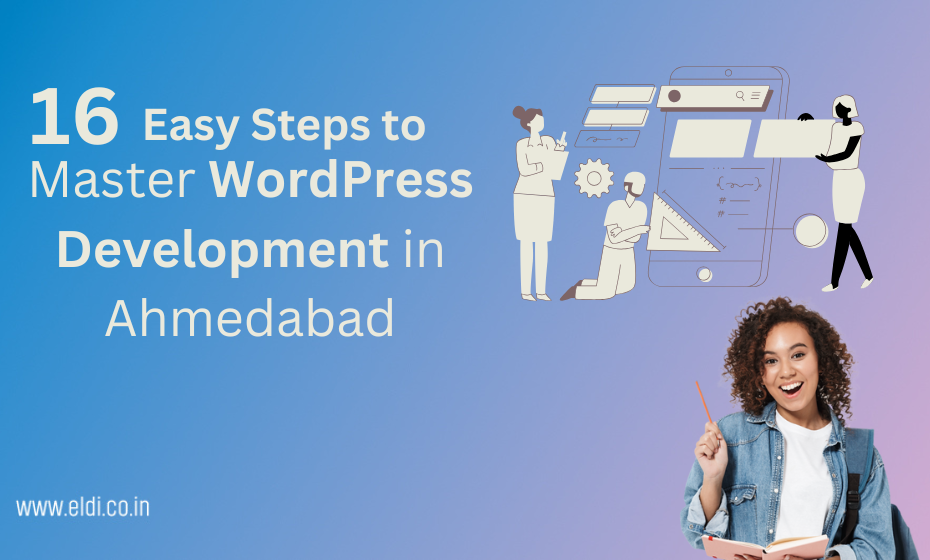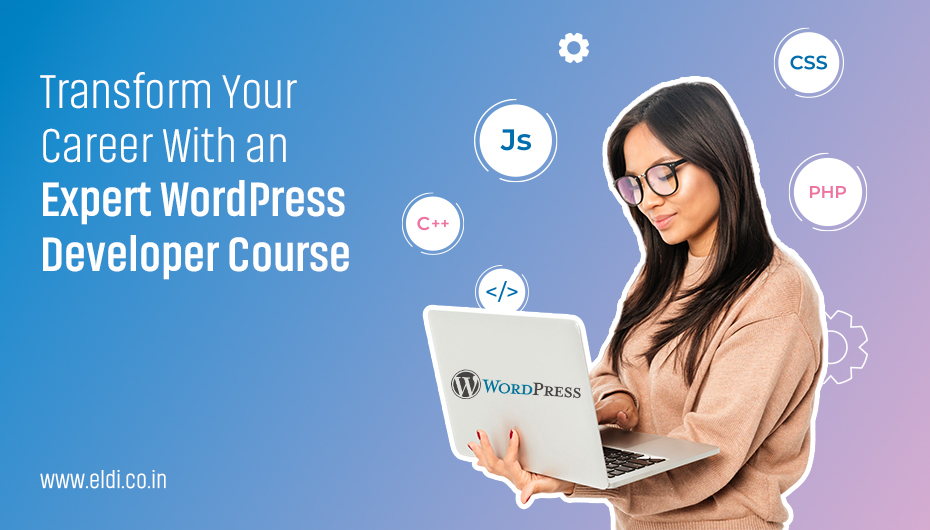
Get in Touch
- 1 Step 1: Basics of WordPress
- 1.1 The essential things are:
- 2 Step 2: Setting Up Your WordPress Website
- 2.1 What you need:
- 2.2 Steps:
- 3 Step 3: Themes and Customizing Your WordPress Site
- 4 Step 4: WordPress Plug-ins
- 4.1 Why Plugins Matter:
- 4.2 Installing a Plugin:
- 5 Step 5: WordPress Content Creation
- 5.1 Content types:
- 6 Step 6: Basic SEO on WordPress
- 7 Step 7: Working with WordPress Widgets and Menus
- 8 Step 8: Basic WordPress Security
- 8.1 For beginners:
- 9 Step 9: Knowing WordPress Hosting and Domains
- 10 Step 10: WooCommerce, E-Commerce with WordPress.
- 11 Step 11: Making WordPress Run Faster
- 12 Step 12: WordPress Debugging and Troubleshooting
- 13 Step 13: Keeping Your WordPress Updated
- 14 Step 14: Learning WordPress Development (Advanced)
- 15 Step 15: Become part of WordPress Communities
- 16 Step 16: Finish Your WordPress Course with a Certificate
- 16.1 Institutes in Ahmedabad:
WordPress is the spine of the Internet, accounting for more than 40% of websites worldwide. This rich content management system (CMS) is known for its user-friendliness, flexibility, and scalability. WordPress development is the door to an excellent IT career in digital marketing and freelance web development for young people in Ahmedabad.
With a flourishing IT sector and a nascent startup culture, opportunities for WordPress developers in Ahmedabad are innumerable. Learning WordPress from a WordPress course with a certificate will give you an edge this summer in a tough job market as a student, fresher, or recent graduate. Here, you will walk through 16 simple yet very effective ways of learning WordPress development explicitly tailored to aspiring developers from Ahmedabad.
Step 1: Basics of WordPress
WordPress is a content management system that allows you to build and manage websites without deep coding knowledge.
The essential things are:
- Themes: Control the layout and design of your website.
- Plugins: Add functionality to your site.
- Widgets: Include interactive elements such as calendars or search bars.
Mastering these basics provides a solid foundation for further learning on advanced topics. WordPress is an essential skill taught in most IT courses in Ahmedabad, making it a great place to start.
Step 2: Setting Up Your WordPress Website
Before you begin coding and contact, you must set up a local environment for practice.
What you need:
- A local server tool, like XAMPP or WAMP.
- A copy of WordPress from wordpress.org.
Steps:
- Install a local server (XAMPP/WAMP) on your computer.
- Download WordPress and place it in the local server’s directory.
- Configure a database and connect it with your WordPress setup.
Practice locally as you test out different changes without the inherent risk of breaking a live site.
Step 3: Themes and Customizing Your WordPress Site
The theme determines the appearance of your site. Here’s how to get started with them:
- Free and Premium Themes: Search the WordPress repository or other online third-party sites for themes that fit the design goals and functionality needs.
- Free themes are perfect for beginners, while most premium themes have advanced features with dedicated support.
- Install and Activate a Theme: Go to WordPress dashboard – > Appearance -> Themes – > Upload or Activate the chosen theme.
- WordPress Customizer: Customize fonts, colours, headers, and layouts directly through the Customizer. Your site will be visually appealing to outside visitors.
- Experiment with Child Themes: Create child themes and keep them intact between updating with your added customizations.
Step 4: WordPress Plug-ins
The plugins are the add-ons for your website.
Why Plugins Matter:
- They save time from the need for custom codes to be written for every minor feature.
- Examples include SEO tools, contact forms, and e-commerce modules.
Installing a Plugin:
- Search for a plugin (for example, Yoast SEO or Elementor).
- Install and activate the plugin.
Ahmedabad has many startups that need developers trained in using plugins to enhance functionalities for web creation.
Step 5: WordPress Content Creation
Engaging content is important for your website.
Content types:
- Posts: For blogs and news updates.
- Pages: For static content like “About Us” or “Contact.”
The Gutenberg block editor arranges content with images, videos, and widgets. This is a trial with content creation in many WordPress courses in Ahmedabad.
Step 6: Basic SEO on WordPress
SEO is basically optimizing your site to be discovered by a search engine. To have the best SEO practices, you need to:
- Use an SEO Plugin: Having either Yoast SEO or Rank Math will help you optimize keywords, assess content, and create a sitemap.
- Meta Information Optimization: Write catchy titles that highlight the content of the meta description with proper keywords for grabbing clicks from search engines.
- Linking: Internal linking for site guides and strong external linking, where necessary, to credible locations.
- Local SEO Usage: For Ahmedabad-based businesses, add location-based keywords to bring in local traffic.
- Track and Improve: Regularly audit your site’s SEO status using tools such as Google Analytics or Ahrefs.
Step 7: Working with WordPress Widgets and Menus
Widgets and menus increase site usability and develop its design.
- Widgets: This widens the house by placing elements such as recent posts, searches, or calendars in the sidebar or footer.
- Menus: Set up a navigation structure that users must follow when interacting with your website.
Practical exercises in a WordPress training course will help you understand how to utilize widgets and menus effectively.
Step 8: Basic WordPress Security
Website security protects it from hackers.
For beginners:
- It is essential to use strong, unique passwords.
- Install a security plugin like Wordfence or Sucuri.
- Keeping WordPress and its plugins updated.
Many WordPress courses with certificates include modules on security, a crucial aspect of web development.
Step 9: Knowing WordPress Hosting and Domains
Essentially, the base and domain that come with hosting are to create a professional-looking website.
- Find the Right Hosting Provider: For optimal performance, security, and scalability, choose WordPress-specific hosting services like Bluehost or SiteGround.
- Know the Type of Hosting: Based on your resource needs and traffic, decide whether you want shared, VPS, or dedicated hosting.
- Choose a Catchy Domain Name: Register a domain related to your brand using platforms like GoDaddy and Namecheap.
- Link Hosting and Domain: To make your website accessible, link your domain to your hosting provider and set up DNS settings.
- Ahmedabad Local Providers: Visit local IT companies and find options for cheap hosting within Ahmedabad to enjoy personalized services.
Step 10: WooCommerce, E-Commerce with WordPress.
With WooCommerce, you can create your own online stores full of functionality. Now, let us show you how to do that.
- Installing WooCommerce Plugin: Add it from the Plugins part of your WordPress dashboard and follow the wizard setup for basic configuration.
- Adding Products: List all items under Products, then write the description, upload the images, and categorize them for easy navigation.
- Configure Payment Gateways: Process payments through Razorpay, PayPal, or direct bank transfers to your bank accounts, allowing customers to choose the most relevant method.
- Configure Delivery Options: Mapping shipping zones, methods, and rates will help ensure smooth delivery.
- Store Personalization: Make friendly, beautiful stores using WooCommerce-compatible themes.
Step 11: Making WordPress Run Faster
A fast website will be good for user experience and ranking on search engines.
Here are Some Tips:
- Install caching plugins like W3 Total Cache.
- Optimize images with the help of tools such as Smush.
- Minimize your CSS and JavaScript files.
You can cover a whole lot of practical optimization techniques in a WordPress full course.
Step 12: WordPress Debugging and Troubleshooting
Problems will happen when you work for WordPress, but your knowledge and skills in debugging will rescue you most of the time.
Some Common Problems:
- Plugin conflicts
- Themes broken
- Database errors
You can use Query Monitor to identify and fix problems. The local WordPress community in Ahmedabad might also be helpful.
Step 13: Keeping Your WordPress Updated
The updates that come in regularly ensure that your site remains safe and functional.
- Backup Your Site: Use plugins such as UpdraftPlus or BackupBuddy to back up data from your site before carrying out your updates.
- Compatibility Check: Check all plugins, themes, and customizations for the compatibility of versions for the latest WordPress version.
- Update WordPress Core: Navigate to Dashboard > Updates for the latest version.
- Update Themes and Plugins: Keep a fresh update for all your active themes and plugins so that they do not have any loopholes open for any issues.
- Test After Update: Test the post-update errors by testing the performance and functionality of your website.
Step 14: Learning WordPress Development (Advanced)
Advanced development generally sharpens your edge regarding customizations and problem-solving.
- Learning HTML and CSS: You must know how WordPress sites are structured and styled. This will help you customize WordPress themes more effectively.
- Know PHP: Go into PHP, which is at the basement index of WordPress, to design custom plugins and functionalities.
- Experiment with APIs: Create applications using the WordPress REST API with external access to services.
- Create a Child Theme: You can create child themes to add distinct features and designs without affecting the parent theme.
- Enroll for IT courses: The advanced-level WordPress course is needed to improve your knowledge and skills.
Step 15: Become part of WordPress Communities
Networking via a WordPress full course enhances how you become a WordPress developer.
- Attend local meetups: Participate in WordPress-focused groups in Ahmedabad to connect with other developers and share experiences.
- Go for Workshops and Events: Attend hands-on workshops to upgrade your skills and keep abreast of current trends.
- Contributions to Online Forums: Use platforms such as WordPress.org forums or Stack Overflow to ask questions, share solutions, and enhance your problem-solving skills.
- Follow WordPress Influencers: Follow WordPress experts and influencers on social media to stay current on industry trends by following
- Team Up locally: Collaborate with Ahmedabad-based developers on projects to gain experience and enhance your portfolio.
Step 16: Finish Your WordPress Course with a Certificate
A WordPress course with a certificate validates one’s ability and thus improves employability.
Institutes in Ahmedabad:
ELDI is the top pick. They have a WordPress full course that’s best for beginners.
You can check the following source for more: Transform Your Future with the ELDI WordPress Course
Unlocking Success: The Importance of WordPress Course for Your Digital Journey




